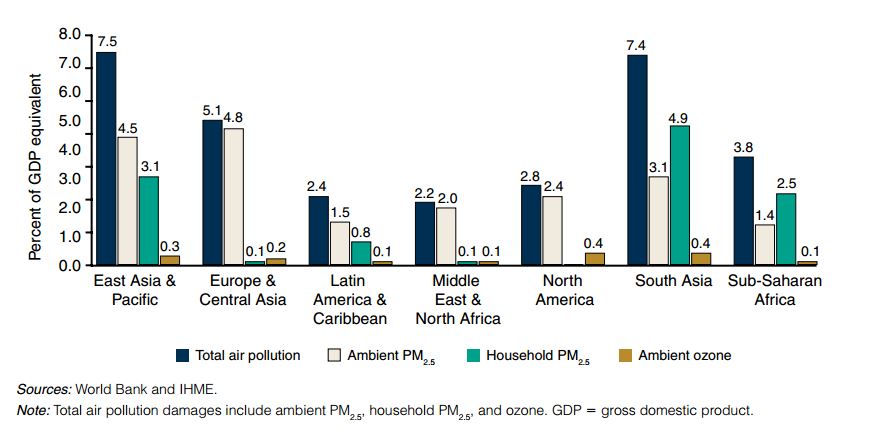The World Bank’s report in 2016;
“The Cost of Air Pollution: Strengthening the Economic Case for Action”
On September 8, 2016, the World Bank issued “The Cost of Air Pollution: Strengthening the Economic Case for Action” as a joint study with the Institute for Health Metrics and Evaluation (IHME). In this report, they estimated that in 2013, 5.5 million premature deaths worldwide were attributed to air pollution, and indicated that air pollution has become not only a health risk but also a burden on economic development. Those deaths cost the global economy about US$225 billion in lost of the labor income and $5.11 trillion in lost of the welfare in 2013
This study sets out to calculate the economic cost of premature mortality from air pollution to strengthen the business case for government to act ambitiously in reducing pollution. From 1990 to 2013, labor income losses had been increased 40%, while welfare losses nearly doubled, which shows that air pollution costs is growing and casting a heavier burden on the economy than ever before.
As for Japan, it was estimated that in 2013, total deaths from air pollution reached 64,428, total labor income losses to $4,414 million and total welfare losses to $240,353 million.
The World Bank requested policy makers in health and environment agencies of each country to seriously consider the results of the report, and immediately address this problem together.
Ambient air pollution and Household air pollution
According to this report, the losses of public welfare accounts for large portion of GDP in South Asia, East Asia and Pacific regions. Figure 1 shows the regional losses of public welfare caused by air pollution in 2013. Household air pollution from cooking with solid fuels was the biggest cause of the losses in South Asia and Sub-Saharan Africa, while in all other regions, the losses were mainly caused by ambient air pollution from particle matters (PM2.5).
 Compared to 1990, ambient air pollution is becoming a more serious challenge. Although the age-standardized death rate due to ambient PM2.5 exposure has decreased in most countries, the number of premature death have increased because of the increase number of exposed population. It was estimated that from 1990 to 2013, premature death attributable to ambient PM2.5 increased by 30%, reached 2.9 million deaths per year. The report shows that about 87% of the world’s population are going to live in areas which are exceeding the pollution standard of the Air Quality Guideline of the World Health Organization (WHO). Labor income losses due to ambient PM2.5, in same period, rose from $103 billion to $144 billion per year.
Compared to 1990, ambient air pollution is becoming a more serious challenge. Although the age-standardized death rate due to ambient PM2.5 exposure has decreased in most countries, the number of premature death have increased because of the increase number of exposed population. It was estimated that from 1990 to 2013, premature death attributable to ambient PM2.5 increased by 30%, reached 2.9 million deaths per year. The report shows that about 87% of the world’s population are going to live in areas which are exceeding the pollution standard of the Air Quality Guideline of the World Health Organization (WHO). Labor income losses due to ambient PM2.5, in same period, rose from $103 billion to $144 billion per year.
Meanwhile, the age-standardized death rate from household air pollution dropped by 38% from 1990 to 2013, although two-fifth of the world’s population was still exposed to household air pollution from cooking with solid fuels in 2013. In fact, because of the population growth, the total number of deaths attributable to household air pollution has mostly remained constant at about 2.9 million per year. The losses of public welfare in low- to middle-income countries reached to $1.52 trillion, and that of labor income from household amounted to $94 billion in 2013.
The impacts on young and elderly
The report also points out that the impacts on young and elderly remained especially vulnerable to air pollution. About 5% of deaths of children under 5 and 10% of deaths of adults over 50-years-old were caused by air pollution, compared with less than 1% among young adults.
This report clearly indicates the economic costs of air pollution is remarkably large. Countermeasures against air pollution are imperative for not only to deal with climate issues, but also to improve health condition from economic perspective.
Reference:
The World BankーThe Cost of Air Pollution : Strengthening the Economic Case for Action, 8 September, 2016
*Downroad file (English) is avairable here.
The Word Bank PRESS RELEASE
Air Pollution Deaths Cost Global Economy US$225 Billion, 8 September, 2016(English link)

